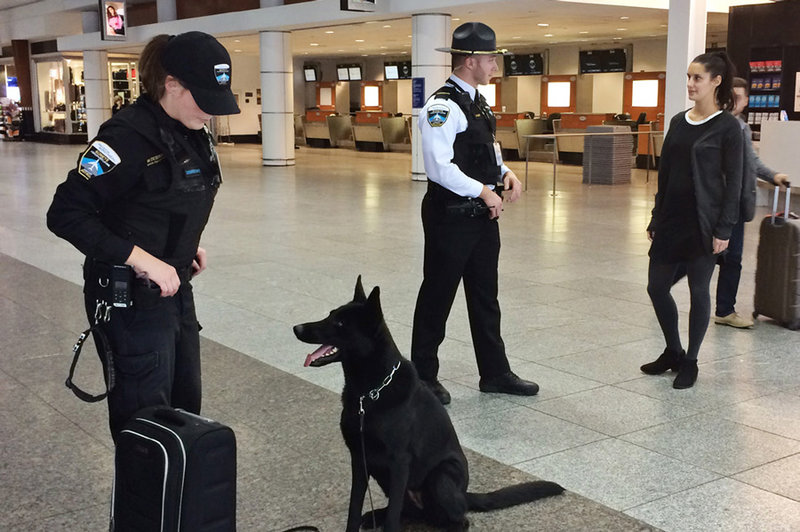Security
Landside security: a top airport priority
While some commentators have gone so far as to call security on the concourse ‘flying’s black hole,’ it’s true that airports around the world are investing more energy and resources in landside security than ever before. Julian Turner spoke to Nathalie Herbelles of Airports Council International to find out more about the multi-layered approach being taken to protect passengers long before they pass through security
N
athalie Herbelles is head of security at airline industry association Airports Council International (ACI), where she is the point of contact for global airport security issues.
Previously, Herbelles worked for the International Air Transport Association (IATA), the Association of European Airlines, Air France, the European Commission and the Spanish Airport Authority (AENA).
Image courtesy of Airports Council International

Image courtesy of
Julian Turner: How is ACI working to ensure that landside and airport concourse security is a priority at international hubs?
Nathalie Herbelles: As ACI head of security, most of my time is spent interacting with airports about how to improve security. Airports are definitely invested in this, they take their responsibilities seriously, and we constantly exchange best practices and try to identify what the next threat is.
The ACI is in constant communication with airports worldwide about where they should be focusing their energy when it comes to issues such as landside security and chemical attacks, and they continually try to go beyond the baseline of basic compliance with Transportation Security Administration (TSA) regulations to find new ways to address threats.
For example, at Hong Kong Airport, which has a large landside area, even staff that don’t have access to secure areas within the airport, including magazine sellers, have some basic level of awareness around security in terms of who to look out for and who to talk to if they spot something suspicious.
iBeacon technology will provide indoor directions, walking times to gates, lounge access and boarding alerts
Are airports doing enough to implement robust security measures on airport concourses?
NH: I would dispute the idea that some airports are not sufficiently investing in landside security and that they don’t take the issue seriously until they’ve been attacked.
The ACI has implemented best practices at airports globally to ensure that a range of issues including surveillance, monitoring, security culture and detection are in place landside to prevent attacks.
The International Civil Aviation Organisation (ICAO) has also just adopted a standard on landside security, which the ACI pushed for and fully supports, meaning airports are now obligated to secure these areas prior to screening.

Image courtesy of Airports Council International
How has the landside security threat evolved and how has the aviation industry responded?
NH: Historically, the focus has been on the secure areas and protecting aircraft. Landside security is not as visible as security screening, so people tend to see those screening procedures as the panacea – once you are screened you are good to go.
That has changed and our members have realised that there are people out there who are radicalised and don’t necessarily need to be part of a large organised plot and can instead attack on their own in those areas of the airport that passengers populate prior to screening.
However, the fact that you don’t necessarily have passenger screening when you enter the terminal areas doesn’t mean that nothing is happening. The ACI published its Landside Security Handbook in order to show what different airports are doing to ensure these areas are still monitored.
For instance, when people drive into the airport area there are ways to slow down vehicles so that they aren’t able to park to close to the terminal building, which also have different types of blast resilience protection.
iBeacon technology will provide indoor directions, walking times to gates, lounge access and boarding alerts
Can you provide specific examples of good landside security practice worldwide?
NH: Brussels Airport is an example of how officers can be stationed in special areas at the terminal entrance to perform random analysis and questioning. The airport has constructed booth-like entrances that allow special officers to monitor people and guide them to the side if they deem it necessary to interview someone.
Adelaide Airport’s forecourt incorporates good environmental design and an attractive environment for passengers, along with many security features such as impact-rated bollards that stop a hostile vehicle at the defined perimeter.
These bollards are examples of a ‘stand-off’ approach that does not need to remain permanent; rather, operable and temporary barriers can be deployed to create a temporary stand-off at specific times when it is required.
One of the more effective methods used in preventing and deterring landside attacks is to perform patrols around the airport environment. Another measure involves the use of canines, as seen at Adelaide Airport and Montreal Trudeau Airport.
Behaviour analysis officers are encouraged to exchange regularly with the people working landside and help them to develop a knack for detecting strange behaviours. Dublin Airport employs this measure and has a programme in place to train and employ specialised officers.
I also know for sure that in the US there is a lot of focus on active shooter training provided by the TSA, and that training security and screening staff is also regulated in the US and elsewhere.
What should airports be doing to improve and refine their landside security strategy?
NH: Effective security relies on a multi-layered approach that combines physical measures, detection and deterrence methods and human factors. This should take into account people, physical design and dynamic measures.
Airports should invest in people through staff training, threat and intelligence sharing and risk analysis. When it comes to detection, security culture, behaviour detection, and public awareness and reporting play a big role.
When addressing the physical design of a terminal or airport facility, or roadway design, airports should look at structural strength and resilience, but also how design can manage the flow of people and incorporate effective prevention measures.
Detection is helped by good lighting and terminal design features. Dynamic measures include physical presence of patrols and effective communication are key in prevention, while detection is bolstered by monitoring, CCTV and overt and covert screening.

Image courtesy of Airports Council International
iBeacon technology will provide indoor directions, walking times to gates, lounge access and boarding alerts
Take us through a recommended airport security risk assessment.
NH: There is a range of options available to airports, depending on their operational realities and their risk environments. Once measures have been agreed, they should be clearly defined in the airport security programme (ASP). For each airport area, the airport should define responsibilities and measures clearly and document them on airport plans.
In a heightened threat environment, it may be necessary to establish additional screening before people enter the airport terminal. Any such screening activities should avoid creating new vulnerabilities such as queues and crowds inside or outside terminal buildings.
It may be appropriate to use random or targeted checks. Mobile technologies or techniques such as explosive trace detection (ETD), behaviour detection officers (BDO) or explosive detection dogs (EDD) may be appropriate to screen passengers quickly and efficiently, for example at London’s Heathrow Airport.
Behaviour detection personnel can be used as both a method of detection and as a deterrent. In addition to security officers specialised in behaviour analysis, basic training on abnormal behaviour detection should be provided to all staff working landside.

Image courtesy of Airports Council International